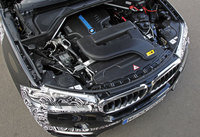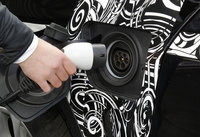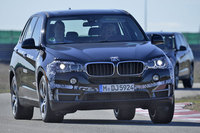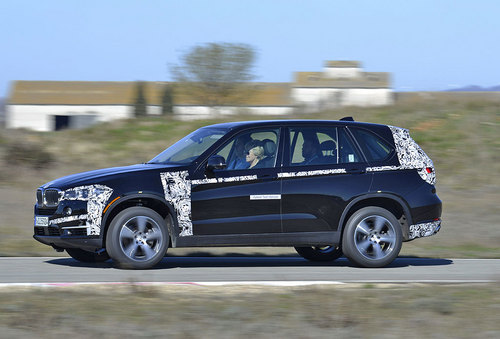2015 BMW X5 PHEV Prototype Test Drive By Henny Hemmes
By Henny Hemmes
Senior European Editor
The Auto Channel
MIRAMAS, France, February 19, 2014. With the i8 sports car, BMW’s first plug-in hybrid electric vehicle, practically ready for its market launch, the Germans offered us some track time in the next PHEV: the X5 eDrive. Even though some development work, testing and fine-tuning will last until the end of this year, we were offered a test drive on the Miramas Proving Ground in the south of France.
After the debut of the Concept X5 eDrive at the Frankfurt auto show last fall, we were expecting more new and now, under the umbrella of the 2014 Efficient Dynamics Innovation Days, BMW provided an inside look and quite some details of the upcoming model.
However, even though we drove a car that feels practically ready, quite some development work, testing en fine tuning still have to be done and it will not be before the spring of 2015 that we will see the X5 PHEV on the market. I would guess the production version will be unveiled at the 2015 Detroit auto show in January.
Of course, a big SUV like the X5 is a model where further ED-measures make a difference. We know that the design of the new X5 has been optimized with aerodynamic details, such as the air curtains and air blades, which will benefit also the PHEV variant.
 |
The 4-cylinder delivers 180 kW/241 hp and 258 pound-feet of torque, while the E-motor delivers 70 kW and 185 lb-ft. This will make it possible to sprint from 0-62 mph in less than seven seconds.
The development engineers say that the average fuel consumption should be around 74 mpg in the EU test cycle with around 89 g/km of CO2. This would mean a decrease of fuel consumption of some 50 per cent.
Feed back from customers show that some 80 percent of them drive their X5 daily for less than 30 km/18 miles, the typical travel distance when people go out of metro areas. In fact that goes for all BMW’s.
Therefore the X5 PHEV is able to drive all electric for up to 18 miles without producing any emissions.
 |
 |
But press the button for the Max e-Drive mode and the vehicle drives all electric. In Eco Pro both drive systems are full-time engaged: the electric propulsion reduces consumption, while the electric boost function offers maximum performance and in the meantime there is maximum efficiency and extended range. In Eco Pro the use of boost is avoided. In Sport mode, both drives are always engaged for maximum performance.
 |
When we drive through the ‘canyon’ of the track, you realize that driving with the X5 PHEV asks for some adjustment of the driver, which you cannot get in a couple of laps. But it this is your daily driver, I can understand that there are situations, that do not ask for boost or performance and then you will be aware of driving more economically. But whoever wants to be in the sporty mood, or needs to get out of a hairy situation, the PHEV will perform as needed.
On the track, the X5 handles very well. As EV there is immediately a good amount of torque and in Sport you can feel the more aggressive response of the throttle and the firmer suspension set up.
BMW says that the weight distribution is not yet optimal. The weight is a little more on the rear axle. This is because the li-ion battery pack lies in the rear. There is no definite weigh, but it should be between 285 and 305 pounds. This is because there still is some development on the way: BMW buys the cells from Samsung, but in makes the modules and combines them in house. Also the software is being developed by BMW engineers.
A look under the hood shows the 4-cylinder lying very deep in the engine compartment and as far back as possible, practically fully behind the front axles. Also the electric control unit is placed in the front.
To achieve the best fuel consumption, the BMW engineers and designers have been working on different measures, which I will highlight tomorrow under ‘BMW X5 Efficient Dynamics Innovations’. Please stay tuned!



